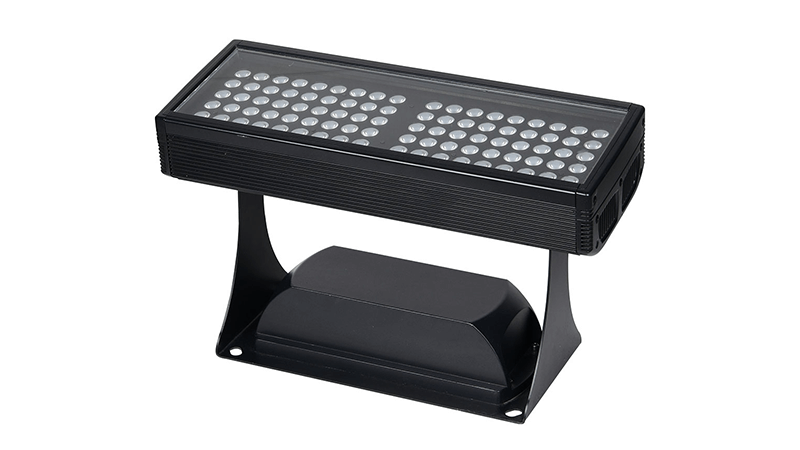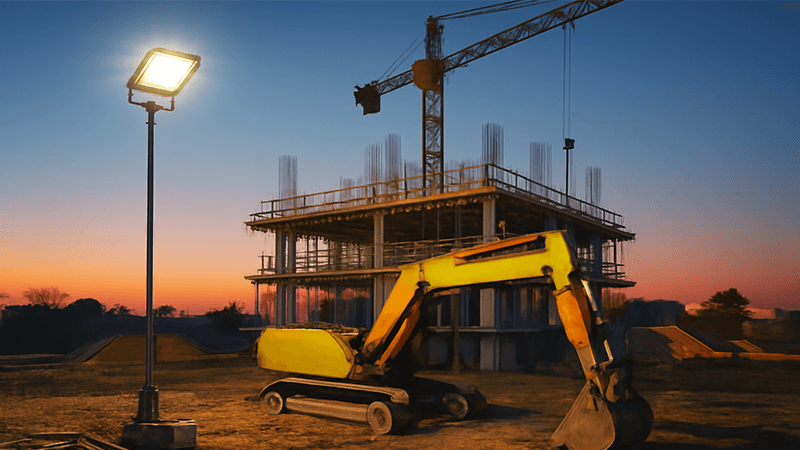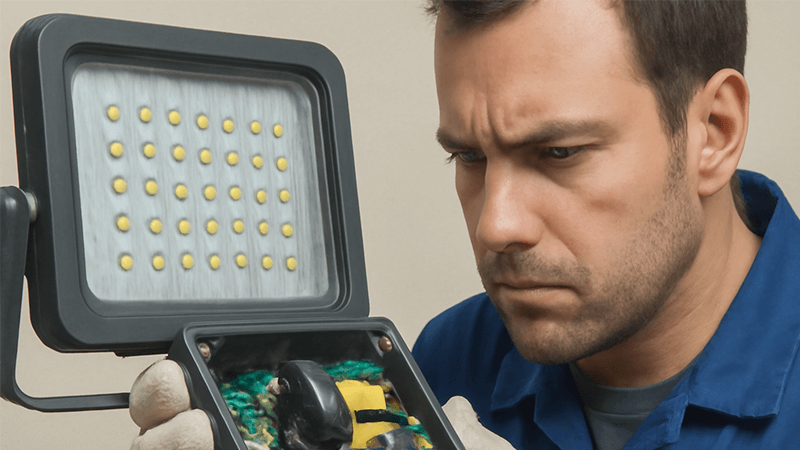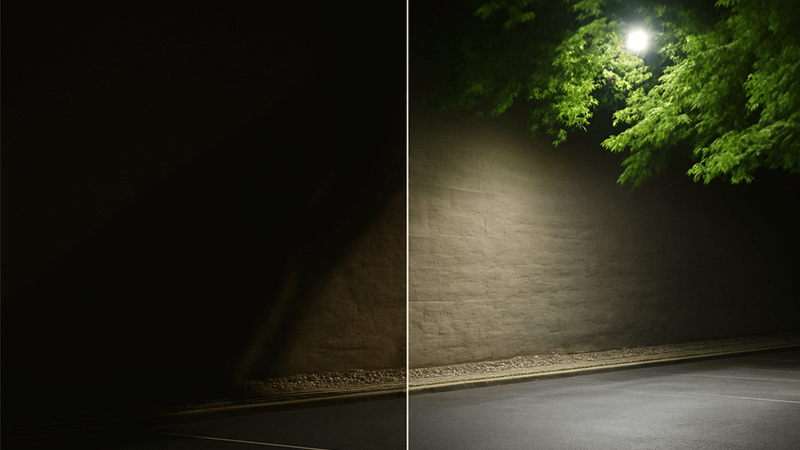Worried about nighttime accidents on your site? Poor lighting creates hidden dangers, leading to costly delays and injuries. LED floodlights provide clear, consistent illumination, making your construction site much safer.
LED floodlights improve safety by providing bright, uniform, and reliable illumination. This eliminates dark spots and shadows, reduces eye strain for workers, and ensures that hazards, equipment, and personnel are clearly visible at all times, preventing costly and dangerous accidents on construction sites.

Ensuring every worker goes home safe is the number one priority. Good lighting is not just a nice-to-have; it’s a fundamental part of a safe site plan. But what makes LED technology specifically the right choice for this demanding environment? Let’s break down the details that matter for partners like Shaz in the UAE, who need reliable solutions for major projects.
Why are LED lights safer?
Traditional lights feel risky, with fragile glass and toxic materials. A simple bump can cause a failure or a hazard. LEDs are built tough, without mercury, making them inherently safer for any job site.
LEDs are safer because they run much cooler, reducing fire risk. They are also solid-state devices, meaning they have no fragile filaments or glass to break. This durability minimizes replacement needs and exposure to hazardous materials like the mercury found in older bulbs.

When I first started in this industry, old metal halide and high-pressure sodium lamps were the standard for construction sites. They were bright, but they came with a long list of problems that we just accepted as normal. Now, with LEDs, we have a much safer alternative. The difference is night and day, not just in the quality of light, but in the physical safety of the fixtures themselves. For a purchasing manager like Shaz, understanding these inherent safety benefits is key to making a sound investment.
Reduced Fire Hazard
The most immediate safety improvement is the operating temperature. A traditional 1000W metal halide lamp can reach surface temperatures of over 400°C (750°F). That’s hot enough to ignite common construction materials like wood, tarps, or packaging. I remember visiting a site where a hot lamp was placed too close to some flammable materials. It was a close call that thankfully didn’t end in disaster. In contrast, a comparable LED floodlight runs significantly cooler, often below 80°C (176°F). This massive reduction in heat almost eliminates the risk of fire caused by the lighting itself, a critical safety factor on any active worksite.
Enhanced Durability
LEDs are "solid-state" lights. This means they don’t have fragile parts like the glass tubes in a fluorescent bulb or the delicate filament in a halogen lamp. An LED is a small, durable semiconductor chip encased in plastic and resin. This makes them incredibly resistant to vibrations, shocks, and impacts—all common occurrences on a construction site with heavy machinery and constant activity. For projects in demanding environments like the UAE, specifying lights with high IP (Ingress Protection) ratings like IP66 is also essential. This ensures the fixture is completely sealed against dust and powerful water jets, preventing internal damage and electrical shorts. A durable light is a safe light because it fails less often and requires fewer risky, high-level replacements.
| Feature |
LED Floodlight |
Metal Halide Lamp |
| Operating Temp. |
Low (~80°C) |
Extremely High (~400°C) |
| Durability |
Solid-state, high vibration resistance |
Fragile filament/arc tube |
| Hazardous Materials |
None (RoHS compliant) |
Mercury, lead, and other toxins |
| Failure Mode |
Gradual dimming over time |
Can shatter or explode |
What are the advantages of using artificial lighting on a construction site?
Are project deadlines impossible to meet with daylight hours alone? Stalled progress costs you money and reputation. Artificial lighting lets you work around the aclock, accelerating completion and maximizing productivity.
The main advantages are extended working hours, which increases productivity and accelerates project timelines. It also significantly improves safety by making the entire site visible, boosts worker morale, and enhances security by deterring theft and vandalism after hours. It’s a crucial investment.

Thinking of lighting as just a way to see in the dark is missing the bigger picture. A proper lighting strategy is a business tool that directly impacts your bottom line. It transforms a construction site from a 10-hour-a-day operation into a 24-hour hub of productivity. It’s not just about spending money on lights; it’s about investing in project efficiency, safety, and security. When I talk with project contractors, we don’t just discuss lumens and watts. We discuss how lighting can help them finish their project weeks or even months ahead of schedule.
Boosting Productivity and Timelines
The most obvious benefit is the ability to run second and third shifts. Critical path activities like concrete pouring, steel erection, or facade installation are no longer limited by the sun. I worked with a contractor in Dubai who was building a major commercial tower. They were falling behind schedule due to some early delays. We helped them design and implement a comprehensive site lighting plan. By being able to work safely through the night, their crews were able to catch up on the timeline within three weeks. This saved them a fortune in potential late-delivery penalties. For a purchasing manager like Shaz, enabling this kind of productivity is a clear way to add value beyond simply sourcing a product.
Enhancing Worker Safety and Morale
Beyond just preventing accidents, a well-lit environment has a powerful psychological effect. A bright, evenly lit site feels more professional, organized, and secure. It shows workers that the company cares about their well-being. This boosts morale and focus, which in turn leads to higher quality work and fewer mistakes. Fewer errors mean less time and money spent on rework. This positive cycle—where safety leads to better morale, which leads to better quality—is one of the most underrated benefits of investing in good lighting. It creates a culture of excellence on site.
| Advantage |
Direct Impact |
Indirect Impact |
| Extended Hours |
Work can continue 24/7 |
Faster project completion, lower overhead |
| Improved Safety |
Hazards are clearly visible |
Fewer accidents, lower insurance premiums |
| Site Security |
Deters trespassers and thieves |
Reduced material and equipment theft |
| Worker Morale |
Workers feel safer and more valued |
Higher quality work, less rework |
Why do LED flood lights fail?
Did your new LED floodlights fail much sooner than promised? It’s frustrating to replace fixtures you thought would last for years. The problem usually isn’t the LED itself, but other key components.
LED floodlights typically fail not because of the LED chip itself, but due to three main causes: overheating from poor thermal management, failure of the electronic driver due to low-quality components or power surges, and moisture ingress from inadequate IP-rated seals.

This is a question I get a lot, and it’s a source of major frustration for buyers. You invest in LED technology for its promised 50,000-hour lifespan, but the fixture dies after just one or two years. The truth is, the LED chip itself rarely fails. The failure almost always happens in the supporting components. As a manufacturer, this is where we focus our attention. A cheap light cuts corners on these critical parts, while a quality fixture is engineered to last. Understanding where to look is how you can tell the difference before you buy.
The Silent Killer: Heat
Even though LEDs are cool to the touch compared to old lamps, they still generate heat at the chip level. This heat must be drawn away effectively, which is the job of the heat sink—the metal body of the floodlight. I’ve seen countless cheap lights that use thin, stamped aluminum or have "fins" that look impressive but are too small and close together to dissipate heat properly. Heat is the enemy of an LED. If it can’t escape, the chip’s temperature rises, which drastically degrades its performance and shortens its life. At my company, iPHD, we use heavy, die-cast aluminum with carefully engineered fins to maximize surface area and airflow. This ensures the heat is pulled away, protecting the LED’s longevity, especially in hot climates like the UAE.
The Driver is the Heart
The LED driver is a small, internal power supply that converts the AC power from the wall into the low-voltage DC power the LEDs need. It’s the single most common point of failure in a low-quality floodlight. To save costs, cheap manufacturers use drivers with undersized capacitors and components that can’t handle temperature fluctuations or slight power surges. When the driver fails, the light goes dead, even if the LED chips are perfectly fine. When sourcing products, I always tell buyers like Shaz to ask about the driver. Seeing a reputable brand name like Mean Well or Philips inside is a strong sign of a quality, reliable fixture.
| Component |
Sign of Quality |
Sign of Poor Quality |
| Heat Sink |
Heavy, die-cast aluminum with deep, well-spaced fins |
Thin, stamped sheet metal; flimsy fins |
| Driver |
Branded components (e.g., Mean Well), high temp rating |
Unbranded, low temp rating, lightweight |
| Seals/Gasket |
Thick silicone gasket, IP66+ rating certified |
Thin foam gasket, no certified IP rating |
What effect does increased outdoor lighting have on safety?
You’ve installed lighting, but are accidents still happening? It’s confusing when a "lit" area is still the scene of a fall. The problem isn’t the light, but the a lack of even light.
Increased outdoor lighting improves safety, but only with proper planning. Poorly placed lights create harsh shadows and glare. When workers move from bright to dark areas, their eyes struggle to adjust, significantly increasing the risk of trips, falls, and other serious accidents.

This brings me to the most critical insight I can share, based on years of visiting job sites. I’ve seen many sites that had powerful lights installed but were still dangerous. The mistake is thinking that more light automatically equals more safety. It doesn’t. In fact, poorly planned lighting can create new dangers. The real goal is not just brightness, but uniformity. This is the difference between a truly safe site and one that just looks bright from a distance.
The Danger of Shadows
The core problem I see over and over is a lack of overall lighting planning. The approach is often to just install a few powerful floodlights on poles and point them downwards. This creates what I call "pools of light." You get areas of extreme brightness directly under the lamps, surrounded by deep, dark shadows. The real danger happens when a worker moves from a bright pool into a shadow. Their eyes, adjusted to the intense light, are temporarily blinded. It can take several seconds for them to adapt to the darkness. In those few seconds of blindness, a worker can easily trip over loose materials, misjudge a step, or walk into an open trench. This transition zone is where so many preventable accidents happen.
The Solution: Uniformity and Planning
The key to safe site lighting is achieving high uniformity. This means the difference between the brightest spot and the dimmest spot is minimal. The entire work area should have a consistent, even level of illumination. You don’t want bright spots and dark spots; you want a smooth blanket of light. This is achieved not by using more powerful lights, but by using a well-designed layout of fixtures with the correct beam angles. For our partners working on large projects, we often run a lighting simulation using software like DIALux. This allows us to create a virtual model of the site and test different fixture placements and optics. The result is a detailed plan that shows the contractor exactly where to install each light to eliminate dangerous shadows and create a truly safe, uniformly lit environment.
Conclusion
LED floodlights make sites safer and more productive. But remember, choosing high-quality fixtures and creating a uniform lighting plan is essential to prevent accidents and ensure true on-site safety.